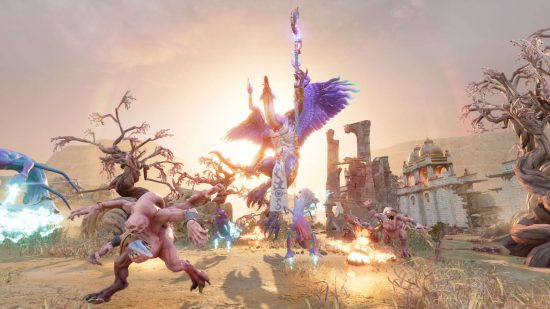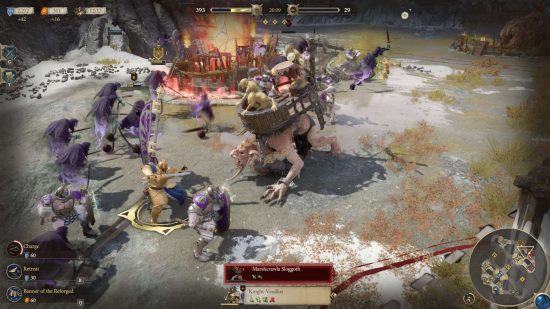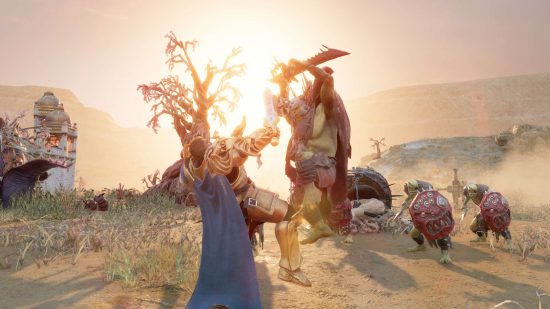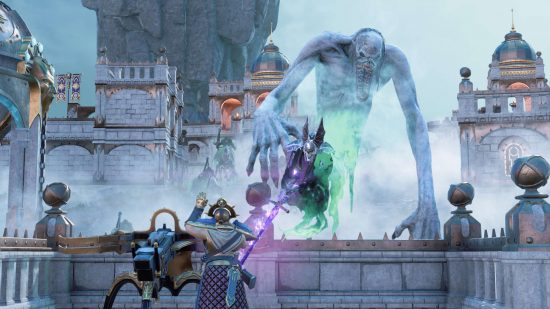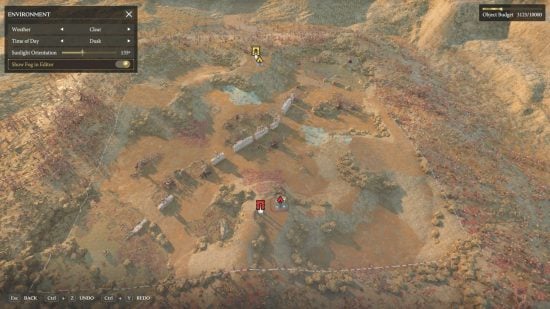Our Verdict
Focusing on the front-lines rather than base-building, this is an RTS all about quick decisions and weighty consequences. Lively animation, stellar audio design, and a robust narrative bring the Age of Sigmar setting to life like never before.
Warhammer Realms of Ruin is a slick, modern RTS, which brings the Age of Sigmar setting to life like never before. Wargamer received two Realms of Ruin review codes, allowing me and editor Alex Evans to trial 1 v 1 multiplayer, 2 v 2 multiplayer against bots, and all the game has to offer in single-player.
Wargamer has been comparing Warhammer Age of Sigmar: Realms of Ruin to Dawn of War since it was first previewed, and having spent plenty of time in previews and hammering the review build, we’re more confident than ever that the comparison stands.
Though far from a carbon copy of Dawn of War or its spin-offs and sequels, the mission structure will be very familiar to anyone who has played those games, or the related Company of Heroes series. This is especially evident in the game’s economy and victory conditions.
The battlefield is dotted with resource generating Arcane Conduits and mission-critical Victory Points. Your supply of units and upgrades relies on the former, while winning the mission requires you to hold the latter, or destroy your opponent’s Command Post.
There’s functionally no base-building here: your Command Post can be upgraded to unlock higher tiers of units and upgrades, while four different kinds of Bastion structure can be built onto each Arcane Conduit, letting you tailor them towards resource harvesting or various forms of battlefield control. All units are summoned from an indestructible Realmgate.
This will disappoint fans of old-school RTS games; turtling isn’t an option, nor are strategies related to structure placement, and your tech tree and choice of units is not tied to your delicate physical infrastructure.
It is a simplification, certainly, but there’s a rationale for it: designer Daniel Saunders told us in an interview that base building was minimised to put players’ focus onto combat. It’s Warhammer, after all, not Househammer.
The basic resource, Command, is generated by any Arcane Conduit you’ve captured, but can only be used to buy your lowest tier units, and activate mundane unit abilities, like charging into melee. Upgrades, powerful abilities, and higher-tier units require Realmstone.
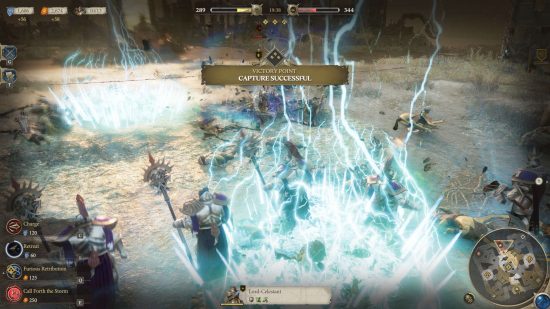
The only way to get Realmstone in any meaningful quantity is by building an aether-harvesting Bastion on top of the Arcane Conduit. That Bastion costs 700 Command, enough to buy five or six basic units. Buying it means giving up on reinforcements, and it will be a priority target for an opponent.
As in any RTS, there’s a rock-paper-scissors distinction between light, heavy, and ranged troops. Being caught in the wrong place at the wrong time will see your forces decimated – deploying the right units to counter your opponent’s force will give you a major advantage. So do you buy units early to push out across the field, or hold back until you’ve got a sense of your opponents’ priorities?
Heroes and some units have abilities fuelled by Realmstone, the biggest and best being a veritable nuclear bomb as the Lord of Change opens a doorway to the Realm of Chaos and devours everything under it. Those can turn the tide of combat, potentially saving your units and smashing the enemy. But we already discussed how important Realmstone is, and how hard it is to get hold of…
Once combat is joined, an engaged unit fights to the death, unless you hit the “Retreat” button, which will send it fleeing all the way back to your Command Post. Units that survive can heal, but they’ll be out of the fight for some time.
That “retreat” button is emblematic of the game’s design. It might appear to remove subtlety from your tactical options. But the effect is to sharpen your options into a stark, binary decision: run and (most likely) live, fight and (most likely) die. How much do you need to hold that Victory Point, or destroy the enemy Bastion parked on a Conduit? What are you prepared to give up?
Unit upgrades are relatively few, relatively pricey – costing as much Realmstone as an advanced unit – and meaningfully powerful, unlocking new abilities or substantial stat buffs, and locking out alternatives.
If I had to pick a word for the gameplay, it would be “clean”. Summoning units and upgrading your force is one button click away, without the mediation of base building. Good unit positioning and timely use of activated abilities will give you an edge in combat, but the binary nature of engagement stops battles from becoming a slog of micro-management. Your choices feel weighty, but the information you need to make them is never far away.
Realms of Ruin has a full narrative single-player campaign, but I’ve only played enough of it to learn the gameplay basics before taking on multiplayer, and Conquest mode.
Multiplayer has been a blast, and connections have been very fast, though that may change when the servers go live to the public. Gamers who tried the beta test for multiplayer will find that it (and all modes other than the single-player campaign) play 30% faster in the launch build than in the beta.

What I’ve seen of the single-player campaign has been promising. The cutscenes in particular are needlessly good. The script, co-authored by Warhammer book author Gav Thorpe, introduces key concepts like the Stormcast Eternals’ DIY immortality and the pan-dimensional Mortal Realms, without becoming an info-dump. The characters are larger than life and likable. The in-engine animation is superb for an RTS, and the voice acting is appropriately epic.
That’s part of a wider picture of audio-visual excellence. Every unit in the game is accurate to its Age of Sigmar miniature counterpart, and brought to life with characterful animations. I’m especially fond of the derpy wobbling walk of Tzeentch’s Pink Horrors, and the lumbering, howdah-bearing Orruk Kruleboyz Marshcrawla Sloggoth.
The main score isn’t quite as revelatory as the soundtracks for Warhammer 40k video games Darktide or Mechanicus, but it’s very serviceable Lord of the Rings-adjacent epic fantasy. AI barks are superb, from the meaningless gibbering of Tzeentch’s daemons, the coffin-door growl of the undead Nighthaunt, to the solemn announcement that “They’re all dead boss. All of them. All dead” when an Orruk unit is wiped out.
I briefly mentioned Conquest mode above: that’s a single-player challenge mode that tasks the player with beating a series of skirmish missions with only a fixed number of lives. Each mission is randomly modified with bonuses or penalties to movement speed, damage output, research rates, fog of war, and so on.
It’s a high-score challenge that should entertain single-player-only gamers; not a substantive addition to the game, but welcome. I keep getting my arse handed to me by ‘Medium’ AI and above.
Another superb feature is the map editor. This is a tidied-up version of the toolset that the level designers used to make the game. I spent more time in this tool than I perhaps should have during my review time – some of the screenshots for this article were constructed using it. The in-game Workshop should make community sharing easy.
Returning to the original comparison – what was it about Dawn of War that left such a legacy? It featured ground-breaking technology, forward looking game design, brilliant multiplayer, and a perfectly cheesy Warhammer 40k story. Most importantly, it introduced tens of thousands of new gamers to the Warhammer 40k universe. If you’re desperate for Dawn of War 4, could Realms of Ruin scratch the itch?
The worst thing I can say about Realms of Ruin is that it’s not truly revolutionary, but it is different enough from classic RTS conventions that it won’t appeal to old-school genre fans. With its loving, characterful recreation of the Mortal Realms, robust game engine, and rock-solid gameplay, Realms of Ruin could be the game that launches Age of Sigmar to mass appeal. If that doesn’t make it a worthy successor to Dawn of War, I don’t know what does.



